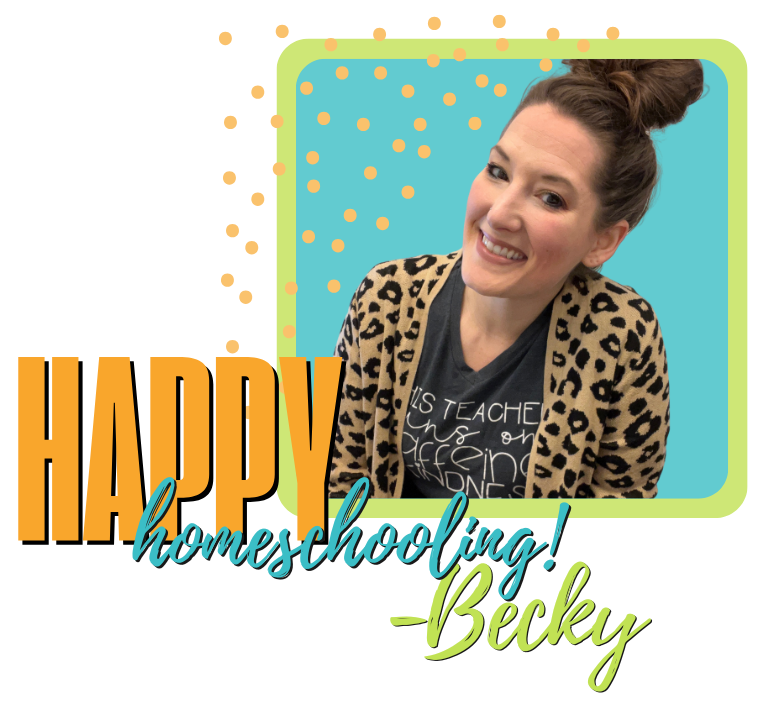The Ultimate Math Toolkit For Homeschool Success: Must Haves to make math time MORE engaging and fun!
As a teacher turned homeschooling mom, I’ve learned one simple truth: having the right tools on hand can turn math from a daily struggle into a fun, hands-on experience. I LOVE having all of our supplies in one easy spot. It helps tremendously when we are in the flow of our learning. It also makes “learning on the go” more doable! Many of the supplies are multi-purpose too. I love getting creative and finding new ways to use the supplies I have. Creating a math toolkit doesn’t have to be complicated or expensive—and I’m here to show you just how doable (and helpful!) it can be.
Here’s a peek at what I keep stocked in our homeschool math toolkit. With these essentials, you’ll be ready for everything from counting to place value to fractions—and you’ll have more fun along the way.
💡 Quick heads-up! Some links in this post are affiliate links. I only share products I truly recommend, and I may earn a small commission if you purchase through them. Thanks for your support!
✨I’m sharing a free PDF download at the end, so don’t miss it! It has a printable checklist of supplies to put your toolkit together. It’s also got a few of the manipulatives like tens frames and number lines so you can easily print them out and add them to your toolkit!✨
Toolkit
There are many great options for putting together a toolkit! You might even have something already on hand that you can use.
I used this storage container from Target for mine. You can see it holds a LOT of stuff!
This is a different container from Target that I also have and would make a great toolkit too!
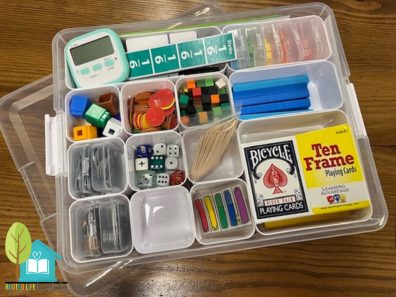
Clear Containers
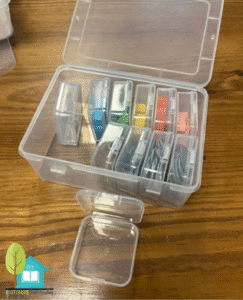
I love clear containers because they help everything stay neat and organized – and easy to see! These are a great size for small objects. They hold the perfect amount of coins for our money practice. We also use them to keep cubes for game pieces. This is probably so silly, but I also love that they come in a nice container that I use to store the ones we aren’t using!
I always have these clear containers on stock!
🧊 Centimeter Cubes (Grouped by Color)
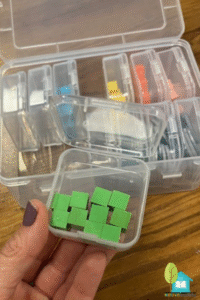
These are perfect for game pieces, quick counting, and sorting activities. I keep sets of 10 in little containers sorted by color, which makes them ideal for game pieces, counters, and game tokens.
Use for: Game pieces, counters, math board games, counting, game tokens, etc.
I love these centimeter cubes because they have so many fun colors!
🧊 Centimeter Cubes (Mixed Colors)

Having a mixed set of centimeter cubes is perfect for a surprising number of activities! These are probably one of our most reached for math manipulatives. They are great for measurement activities (because they are each one centimeter!!), counting, addition and subtraction, skip counting, place value, and even multiplication and division.
Use for: Place value (ones), area/perimeter models, visual math support
They are the same cubes as linked above!
💵 Coins (Real or Play Money)
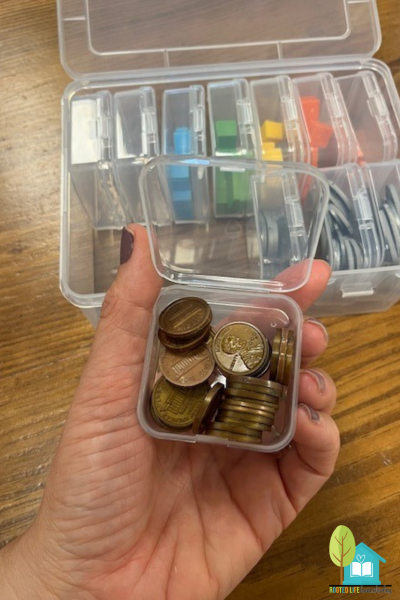
Money math is so practical and fun! I recommend grabbing a set of play coins or collecting real coins. Thrift stores and garage sales are gold mines for old board games with play money. We like to use money to play store! This is an easy activity to build upon as your children get older – and can easily be differentiated if you are working with children at different ages and stages!
Use for: Counting, making change, skip counting by 5s and 10s
This play money set includes coins and bills – which is helpful to have on hand!
This is a great option for coins.
🎲 Dice Mix

Keep a small container with different types of dice (6-sided, 10-sided, 12-sided, even dice with operations!). They’re perfect for fast-paced games to build fluency.
Use for: Addition/subtraction games, multiplication fact races
I LOVE these dice – they come in a TON of color options (over 30 colors!) and there are 7 different dice: 4 sided, 6 sided, 8 sided, two 10 sided, 12 sided, and 20 sided!
Having some blank dice is also helpful too! I like to use these to make operation dice for addition and subtraction and even for multiplication! They are also super great when you want to practice specific facts (maybe adding with 8s or 9s).
📏 Two-Sided Counters

These are a great tools for practicing number combinations, addition and subtraction, counting with one to one correspondence, and even simple patterning. Flip between red and yellow to model problems. Think about 5+2 by using 5 yellow and adding 2 red. Practice subtraction with problems like 18 – 6 where you have 18 red and turn 6 over to the yellow side. Practice “Friends of 10” by showing different combinations of red and yellow.
Use for: Subitizing, part-part-whole problems, game tokens, patterning, addition and subtraction
I like both these foam double sided counters and these magnetic double sided counters.
🧰 Base Ten Blocks
If you’re working on place value, you NEED these! The visual and tactile feedback makes understanding tens and hundreds so much easier. It really helps build a concrete understanding of place value. I love using these for addition and subtraction – especially when we get into problems requiring carrying and borrowing.
Use for: Regrouping, expanded form, number building
This is a great option for base ten blocks – it has 100 ones units, 20 tens rods, 10 hundreds flats, and one 1,000 cube. That’s perfect for building up a great understanding of place value!
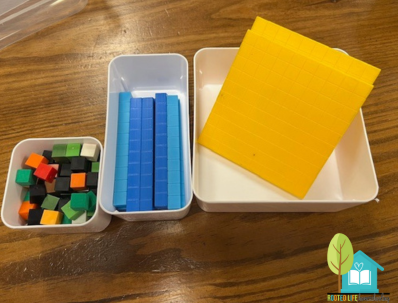
🔢 Ten Frames

Tens frames. are one of the best tools for building number sense, especially in early elementary. I don’t remember using these when I was growing up, but as I learned about them from being a teacher, I fell in love with how powerful and helpful they are for so many math concepts! They really are an incredible visual for children as they are developing foundational number sense and relationships! We use these with some of our cubes, dry-erase markers, or other little objects we have on hand. I especially love helping my children recognize numbers in terms of 5 and 10. For example, 7 is 5 and 2 more, and 8 is two less than 10.
Use for: Subitizing, addition, missing addend practice
You can get a free download of the tens frames and some of the other resources at the end of this post.
🔹 Number Lines
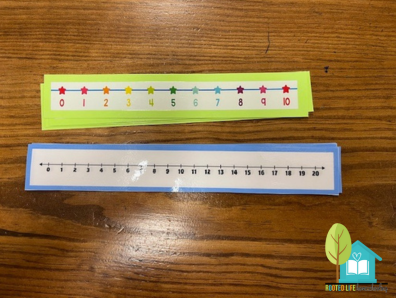
Having number lines is a great way to practice so many skills. They are great for beginning counting as they help show number progression. They are also great for addition and subtraction too! We also use them to build an understanding of number relationships and strategies like counting on, finding the difference, and skip counting. You can easily add in number lines to activities you are already doing. I especially love that they help connect recognition of the numbers themselves as you work on different skills!
Use for: Addition, subtraction, and visualizing jumps on a line
You can get a free download of the number lines and some of the other resources at the end of this post.
📰 Touch Point Cards
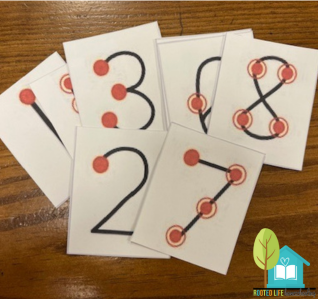
If your child is a tactile or visual learner, Touch Point Cards can be incredibly helpful. These cards use dots or touch points to represent numbers, helping kids count by touching each dot. This system supports early learners who are still developing number sense and can serve as a bridge to more abstract mental math. The dots on the cards are meant to be touched while counting. Dots with an outer circle are touched twice as the child counts. These are especially helpful when working with addition and sutraction!
Use for: Number recognition, subitizing, counting strategies, building fluency with addition and subtraction
You can get a free download of the touch point cards and some of the other resources at the end of this post.
⏲️ Timer

I love using timers to set goals and create a little excitement during practice. Kids focus better when they know it’s just for 5 or 10 minutes. Sometimes I’ll use our timer so that our math warm up games give us a good amount of practice without overtaking our math lesson. Many times a timer can be set for 5 minutes so that whoever has the most points or is closest to the finish line when the timer goes off is the winner.
Use for: Timed math games, fluency practice, focus time
I love this set of two timers. I use one for our math toolkit and I have the other one out and accessible to use at other times during out day.
I also LOVE LOVE LOVE LOVE visual timers like this one! This one is too big to fit in a math toolkit though! Hahah!
🎮 Playing Cards, Blank Cards, and Ten Frame Cards

There are SO many card games that reinforce math! You can also create your own with blank playing cards and a Sharpie.
I love our tens frame playing cards SO much. I love playing the “matching game” either by making actual matches (like 2 and 2) or as we practice concepts like “friends of 10” or making a certain number using addition and subtraction.
Use for: Math games, fact fluency, skip counting
This is a great deal for blank playing cards.
I think the best deal for a regular deck of playing cards is probably at Wal-Mart or other similar stores.
🌁 Game Spinner

You can make your own or grab a reusable spinner base. Perfect for spinning up quick review games! This kind of game spinner is so fun to use for making up your own games. You can easily add spaces like “lose a turn” or “add 4 tokens” when you have a game spinner like this. My kids enjoy making up their own spinner spaces when we use these for our learning. I love seeing their creativity too!
Use for: DIY math games, review activities, graphing
This pack of 5 spinners is a great option. You can even use some of the extras for other areas of your homeschool – like having your child make up their own little “movement” or “brain break” spinner with things like: 5 jumping jacks, 10 sit ups, 7 toe touches, 6 frog jumps, etc.
I also included some printable spinner templates that you can use with your spinner if you’d like! They are in the free PDF download at the end of this post. You can print them, cut them out, and then either write on the printed spinner sections OR use a whiteboard marker to write on the clear spinner.
🔹 Unifix Cubes
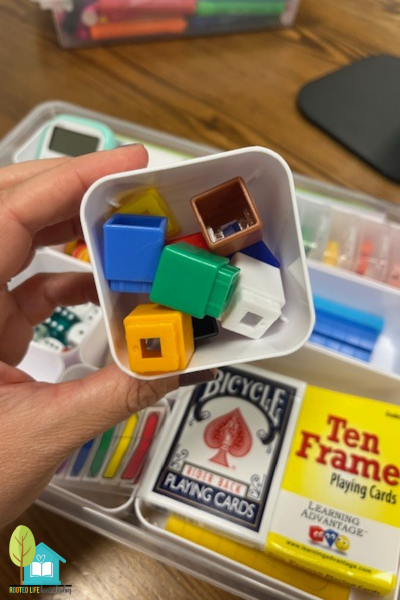
These are great for building and manipulating groups. They build together easily, making them ideal for visualizing math concepts. You can use a handful of them in your math toolkit for things like game pieces, measuring, counting, adding and subtracting, etc. Then you can use the rest for other math skills and concepts like place value. I especially love to use them when we are working with understanding teen numbers as a group of ten and extra ones and then as we add and subtract with teen numbers! These are also SUPER helpful with multiplication and division because you can easily group them together.
Use for: Measurement, counting, solving word problems, place value, multiplication, division
This is a great simple set for Unifix Cubes.
🧈 Toothpicks
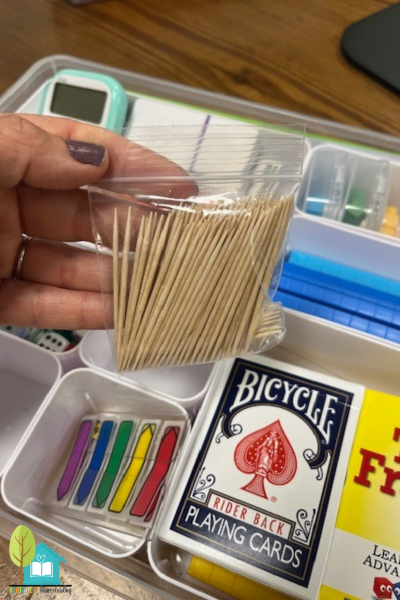
Toothpicks are an underrated supply! We use them to build shapes, work on symmetry, and solve logic puzzles. They are so fun to use with building shapes because we can really get creative! Sometimes drawing polygons can be tricky, so toothpicks offer really great practice. I also LOVE using them when we work on “greater than, less than, and equal to” so that we can show the >, <, and = symbols. For that activity, I like to use the the blank playing cards to build numbers: I’ll write numbers 0-9 on the blank cards and then us them to make different numbers to compare.
Use for: Geometry, problem-solving, visual-spatial skills
You probably already have some toothpicks you can add to your kit! If not, grab some on your next grocery run!
📇 Post-Its and Sticky Arrows

Use sticky notes to label workbook pages, mark where you left off, or even for quick note-taking. The arrow-shaped Post-Its make great game pieces too – especially if your math curriculum has games in it and your child’s book doesn’t lay flat. I also like these for when there are certain parts of the teacher’s guide lessons that I do NOT want to forget!
Use for: Organization, labeling, interactive notebooks
I love these Post-It arrow flags in these bright and fun colors!
🔢 Magnetic Fraction Strips
These give kids a clear, hands-on way to explore fractional parts. Magnetic versions are fun to use on whiteboards or on the fridge.
Use for: Fractions, comparing sizes, equivalence
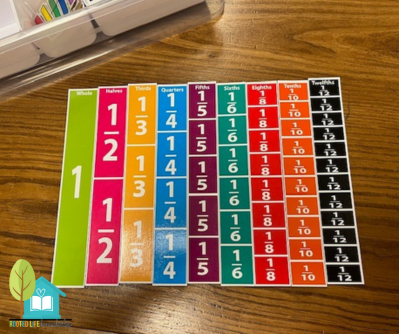
I love the fraction magnets I have because each strip is “whole” and doesn’t have individual pieces. It makes it easy to store in our toolkit that way. Unfortunately, I couldn’t find our exact set when I went to link it here. There are MANY sets of fraction magnets on Amazon, though all the ones I could find have individual pieces (so their strip of 8ths is 8 pieces). These sets are AMAZING and so helpful but might be better stored in a different way. Here’s one that I found that I looks like a great option: Magnetic Fraction Tiles Circle Set
While we’re at it, if you’re interested in fraction manipulatives that are helpful (and once again, that don’t fit in the toolkit), I have these fraction cubes as well and they are fantastic!
⭐ And since I think that having fraction strips in your toolkit is helpful, I created a quick little printable resource that I think serves as a good alternative! You can grab it as a free download at the end of this post along with the tens frames, number lines, and touch point cards!
✍️ Sharpie Marker
I use a Sharpie all the time! Perfect for labeling blank playing cards or creating quick labels for containers.
Use for: Writing on blank playing cards, labeling supplies
I’m sure you have a few of these laying around that you can toss in to your toolkit!
✨ Free Bonus: Printable Math Toolkit Checklist
To help you get started, I created a free printable checklist of all these items. Print it out and check off what you have (or want to get next).
✨Grab your Printable Math Toolkit Supply Checklist!✨
This checklist includes links to the supplies listed in this post! You can easily shop the supplies by clicking the link at the bottom of the checklist page or by scanning the QR code.
It also includes:
-Tens Frame printables
-Number Lines 0-10 printables
-Number Lines 0-20 printables
-Touch Point Cards printables
-Game Spinners printables
-Fraction Strips printables
🔍 Final Thoughts
You don’t need to buy everything all at once. Start small, grab what makes the most sense for your current math focus, and add to your toolkit over time. Some of the items might be ones you already have around the house, some you might keep an eye out for as you’re out and about, and some might even be found on Facebook Marketplace or at garage sales! The goal is to make math more fun, hands-on, and stress-free for both you and your child.
With the right tools in your kit, you’ll be ready for math adventures every day!
Looking for a quick way to shop? I linked all of these items in one place on my Amazon Storefront! You can shop here!
Happy math-ing!
